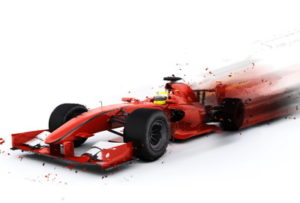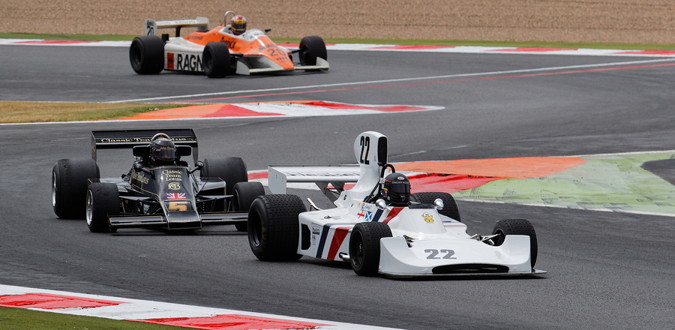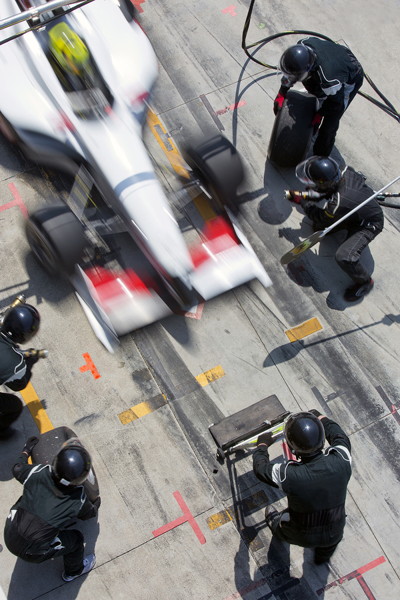Formula 1 Betting Sites & Offers
 With glamour, speed, exotic locations, super star celebrities and full race TV coverage Formula 1 is one of the UK’s most watched sports. In many ways motor racing seems a simple sport, drive around a lap in the fastest possible times to win, but anyone who has raced will know this is in fact one of the hardest sports on the planet.
With glamour, speed, exotic locations, super star celebrities and full race TV coverage Formula 1 is one of the UK’s most watched sports. In many ways motor racing seems a simple sport, drive around a lap in the fastest possible times to win, but anyone who has raced will know this is in fact one of the hardest sports on the planet.
Formula 1 is a balance of producing the fastest car to qualify with while maintaining the stamina to win a nearly 2 hour long race. This gives punters plenty to place a wager on and F1 bookmakers now offer hundreds of lines to bet on. Punt on the outright race winner, pole position winner, fastest lap, podium finish, top 10 finish, safety car appearance, number of retirements, plus many more markets.
Formula One is a sport with plenty of revenue, sponsorship and advertising and so you can rely on betting sites getting involved with top markets. Here we cover some of the top formula 1 offers and the best formula 1 betting sites. In recent years the domination of the sport by Red Bull and then Mercedes has meant offers have been rare, as it is often obvious who will win. Lately however the sport has become more competitive so hopefully the number of promotions will start to increase.
F1 Free Bets, Bonuses & Featured Specials


There are very few F1 offers these days and this is largely due to the dominance of a small group of drivers that now win most races. The reliability of the cars has also improved so much that it is difficult for bookies to push the old style retirement-insurance offers they used to run.
Ladbrokes odds boost is therefore one of the best promotions you can use associated with Formula One. It lets you boost the price of any bet you would like to place on stake values up to £50 once each day. All winnings are cash.
Considering this bookie also have more expansive markets than most others it makes sense to use their odds boost feature to add some value to a sport where it is hard to find decent promotions.
Best F1 Betting Sites & Bookmakers
Ladbrokes
If market choice is what you are after then Ladbrokes will have you covered. They have the biggest range and depth around and can be relied on for odds competitiveness and high payout limits.F1 History, How To Race, Rules and Major Events
 In many ways, every sport is just a more officially organised version of something that people tend to do in their spare time. The best snooker player in your local club no doubt watches the World Championship play out and imagines that they could give it a good go if they were only given a chance. Thousands of tennis players head out to their local park after watching a day of Wimbledon, whilst Sunday league footballers no doubt have an extra spring in their step when they take to the pitch after seeing the FA Cup final. Yet perhaps no sport is as underestimated in terms of just how difficult it is as Formula 1. After all, there were more than thirty million cars on the roads of the United Kingdom in 2016, so it’s little wonder that some people feel that they could finish on the grid if they were asked to step in at Silverstone.
In many ways, every sport is just a more officially organised version of something that people tend to do in their spare time. The best snooker player in your local club no doubt watches the World Championship play out and imagines that they could give it a good go if they were only given a chance. Thousands of tennis players head out to their local park after watching a day of Wimbledon, whilst Sunday league footballers no doubt have an extra spring in their step when they take to the pitch after seeing the FA Cup final. Yet perhaps no sport is as underestimated in terms of just how difficult it is as Formula 1. After all, there were more than thirty million cars on the roads of the United Kingdom in 2016, so it’s little wonder that some people feel that they could finish on the grid if they were asked to step in at Silverstone.
As with all professional sports, however, the level of difficulty involved in being a professional F1 driver cannot be overstated. Operating a Formula 1 car is difficult enough when compared to commercial vehicles that an average driver might know how to use, without taking into account the likes of how fast the cars are travelling and needing to communicate with your team in the pit. It is arguably one of the most specialised jobs of any sport, requiring not just skill but also training that far exceeds most other sports. That’s not to downplay the skill of rugby players, jockeys or baseballers, of course, but each of those either require no equipment of equipment that is not worth millions of pounds in the same way that race cars are. On this page we’ll have a look at the sport’s history, as well as how it works and what the biggest competitions in it are.
History Of Formula 1

Formula 1 can trace its history back to the end of the nineteenth century, when organised automobile racing took place in France on a regular basis. Initially that began life as racing from one French town to the next, with the first to arrive being declared the victor. That soon developed into more of an endurance test for both the drivers and their cars. Because the races were held on public roads, dangerous accidents were not uncommon and soon the safety of both those taking part in these ‘grand prix’ races and the pubic at large began to be taken into account. At the turn of the twentieth century this resulted in the formation of the Association Internationale des Automobile Clubs Reconnus, or AIACR, which was an organisation created by French motor clubs. In 1922 they created the Commission Sportive Internationale and asked them to regulate the sport and in 1946 they declared Formula 1 to be the ‘premier single seater racing category in worldwide motorsport’.
That ruling came into effect in 1947 and initially the sport had a host of different names. It was known variously as Formula A, Formula I or Formula 1, with the second-tier of racing similarly having a slew of names to choose from in Formula B, Formula II or Formula 2. It wasn’t until 500c racing came in with the name of ‘Formula 3’ in 1950 that there was any sort of standardised naming for the different levels of the sport. Prior to the Second World War, the sport was defined by engine capacity, but a new regulation came into effect in 1946 that changed all of that. Non-supercharged cars with 4.5 litre engines could go up against pre-war supercharged 1.5 litre engines, but supercharged 3 litre engines weren’t allowed to race. The first occasion that these new rules were used was in 1946 when Achille Varzi won the Turin Grand Prix driving a 158 Alfetta Alfa Romeo. That was in the era before driver or constructor championships, when roughly twenty races were held between Spring and Autumn.
 That was also the time of Italian cars ruling the roost, with Alfa Romeo leading the way. After 1950, though, they began to get some competition from cars being produced in Germany. The newly found competitiveness came about because of a response from the FIA to the launch of the Motorcycle World Championships in 1949. In order to maintain interest, the FIA launched the Drivers World Championship, which included six Grand Prix races and the Indianapolis 500. This was the time for the Factory-based car makers to come to the fore, with Ferrari and Maserati well-positioned to do so. Prior to 1950, Alfa Romeo was the winning car in all but one of the major races that took place. Then, in 1951, Enzo Ferrari realised that it was a mistake to keep going after a 1.5 litre engine as it used too much fuel and required too many pit-stops. Instead he developed the V12 4.5-litre, which used less fuel and made Ferrari almost untouchable.
That was also the time of Italian cars ruling the roost, with Alfa Romeo leading the way. After 1950, though, they began to get some competition from cars being produced in Germany. The newly found competitiveness came about because of a response from the FIA to the launch of the Motorcycle World Championships in 1949. In order to maintain interest, the FIA launched the Drivers World Championship, which included six Grand Prix races and the Indianapolis 500. This was the time for the Factory-based car makers to come to the fore, with Ferrari and Maserati well-positioned to do so. Prior to 1950, Alfa Romeo was the winning car in all but one of the major races that took place. Then, in 1951, Enzo Ferrari realised that it was a mistake to keep going after a 1.5 litre engine as it used too much fuel and required too many pit-stops. Instead he developed the V12 4.5-litre, which used less fuel and made Ferrari almost untouchable.
When the new rules of Formula 1 had been announced by the FIA they had said that the rules would remain in place until 1954, meaning that it would be incredibly difficult for any other car manufacturers to catch up with Ferrari. Indeed, the Italian maker went on to win the 1952 and 1953 championships. 1953 was the first year that an F1 race took place outside of Europe when one was moved to Argentina, with a rule then being instigated that at least one race would occur outside of Europe every year moving forward. The rules regarding engine size changed ahead of the 1954 season and that allowed new car manufacturers to get involved and suddenly Ferrari didn’t rule the roost any more. Mercedes then went on to win the championship in ’54 and ’55. The history of the sport since than has mostly involved changes to rules and the rise of different car makers able to take advantage of the way the engines worked. There have also been numerous safety regulations brought in place to protect both drivers and spectators as much as possible.
Formula 1 Format and Rules
 Formula 1 can be seen as two separate competitions that take place over a given number of racecourses throughout the year. The first competition is between the drivers, who compete for the Drivers Championship. The second is between the car manufacturers who attempt to win the Constructors Championship. The season now runs from March to the end of November and takes place across more than twenty different race tracks. The races take place on weekends and involves three different practice sessions, a qualifying race and then the race itself. The practice sessions last for ninety minutes each on the morning and afternoon of the Friday and there is then a sixty minute session ahead of qualifying on the Saturday.
Formula 1 can be seen as two separate competitions that take place over a given number of racecourses throughout the year. The first competition is between the drivers, who compete for the Drivers Championship. The second is between the car manufacturers who attempt to win the Constructors Championship. The season now runs from March to the end of November and takes place across more than twenty different race tracks. The races take place on weekends and involves three different practice sessions, a qualifying race and then the race itself. The practice sessions last for ninety minutes each on the morning and afternoon of the Friday and there is then a sixty minute session ahead of qualifying on the Saturday.
The qualifying phase is split into three stages, known as Q1, Q2 and Q3. Drivers get eighteen minutes in Q1 to see how quickly they can get around the track, with the six slowest times eliminated and given the final six places on the starting grid when it comes time for the race proper. Times are set back to zero for Q2 and the cars and drivers that weren’t eliminated then get fifteen minutes to clock their fastest time. Once more, the six poorest performing cars are eliminated ahead of Q3 and know that they will take up places eleven to sixteen on the grid, depending on how they performed. In Q3 the cars that are still remaining get twelve minutes to see how quickly they can get around the track in the hopes of finishing the quickest and getting pole position the starting grid.
When it comes time for the race itself, it can last no longer than two hours. The only exception to this is if there’s an accident or dangerous conditions on the track that results in the race being ‘red-flagged’. If that happens then the race can be extended, but to no longer than four hours. All Constructors have to choose the type of tyre that they want their cars to use, with the same manufacturer responsible for all. They can choose from five different dry weather tyres, which are as follows:
- Ultra Soft
- Super Soft
- Soft
- Medium
- Hard
There’s also the chance to take we weather tyres that are either Intermediate or Full Wet. When the race starts, cars will be fitted wit the tyres that they had on for their fastest lap during the qualifying phases. In terms of fuel, cars have a limit of around one hundred and thirty litres and can consume no more than one hundred kilograms of fuel per hour.
Team put forward two drivers for each race, with the drivers part of the same team but competing as individuals. Points are awarded according to where drivers and their cars finish the race. It works as follows:
- 1st – 25 Points
- 2nd – 18 Points
- 3rd – 15 Points
- 4th – 12 Points
- 5th – 10 Points
- 6th – 8 Points
- 7th – 6 Points
- 8th – 4 Points
- 9th – 2 Points
- 10th – 1 Point
Points are added up at the end of the season and the driver with the most points wins the Drivers Championship, whilst the team with the most points from both of their drivers wins the Constructors Championship.
Major Formula 1 Events and Competitions

The tricky thing when it comes to discussing Formula 1 is that there’s really only two different competitions to speak of: the Drivers Championship and the Constructors Championship. They take place over countless different racecourses, as mentioned, but there’s no point in breaking them down individually as it would be like looking at which team has won most often at Old Trafford when discussing football. Here’s how the two Championships work:
The Drivers Championship – First awarded in 1950, the title is given out each season when it becomes mathematically impossible for another driver to overtaken the winner on points. This means it doesn’t always go to the last race of the season, with only twenty-nine of the sixty-eight seasons at the time of writing finishing with the last race.
The Constructors Championship – This was first awarded in 1958 and is given to the Formula One constructor that has won the most points over the course of the season. Since it was first introduced, just fifteen different constructors have won the championship.
Facts & Figures
| Competition | Most Successful |
|---|---|
| The Drivers Championship | Michael Schumacher |
| The Constructors Championship | Ferrari |



 ;
;

